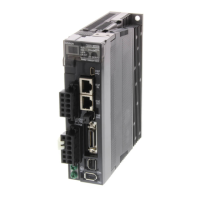11-1
11-1 Troubleshooting
OMNUC G5-SERIES AC SERVOMOTOR AND SERVO DRIVE USER'S MANUAL
11
Troubleshooting and Maintenance
11-1 Troubleshooting
Preliminary Checks When a Problem Occurs
This section explains the preliminary checks required to determine the cause of a problem if
one occurs.
Checking the Power Supply Voltage
Check the voltage at the power supply input terminals.
Main Circuit Power Supply Input Terminals (L1, L2, L3)
R88D-KT@L (50 to 400 W) : Single-phase 100 to 120 VAC (85 to 132 V) 50/60 Hz
R88D-KT@H (100 W to 1.5 kW) : Single-phase 200 to 240 VAC (170 to 264 V) 50/60 Hz
(750 W to 1.5 kW) : 3-phase 200 to 240 VAC (170 to 264 V) 50/60 Hz
(2 to 15 kW) : 3-phase 200 to 230 VAC (170 to 253 V) 50/60 Hz
R88D-KT@F (750 W to 15 kW) : 3-phase 380 to 480 VAC (323 to 528 V) 50/60 Hz
Control Circuit Power Supply Input Terminals (L1C, L2C)
R88D-KT@L (50 to 400 W) : Single-phase 100 to 120 VAC (85 to 132 V) 50/60 Hz
R88D-KT@H (100 W to 1.5 kW) : Single-phase 200 to 240 VAC (170 to 264 V) 50/60 Hz
(2 to 15 kW) : Single-phase 200 to 230 VAC (170 to 253 V) 50/60 Hz
R88D-KT@F (750 W to 15 kW) : 24 VDC (21.6 to 26.4 V)
If the voltage is out of range, there is a risk of operation failure. Be sure that the power supply is
within the specified range.
Check the voltage of the sequence input power supply (+24 VIN terminal (CN1 pin 7)).
It must be between 11 and 25 VDC.
If the voltage is out of range, there is a risk of operation failure. Be sure that the power supply is
within the specified range.
Checking Whether an Alarm Has Occurred
Make an analysis using the 7-segment LED display area in the front of the Servo Drive and using
the Operation keys.
When an alarm has occurred
…
Check the alarm display that is displayed (
@@
) and make an analysis based on the alarm that is
indicated.
When an alarm has not occurred
… Make an analysis according to the error conditions.
In either case, refer to "11-4 Troubleshooting" (P.11-10) for details.

